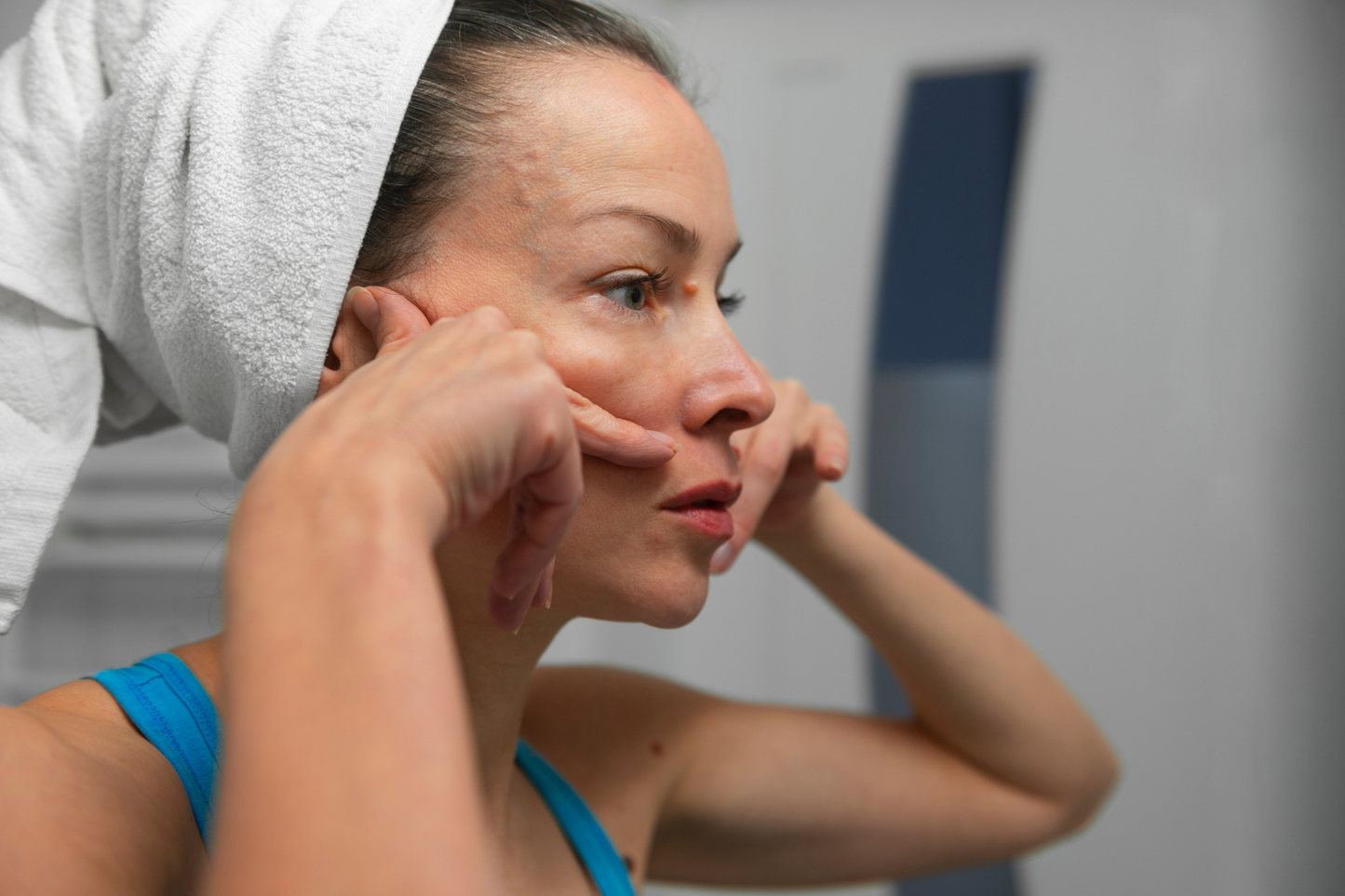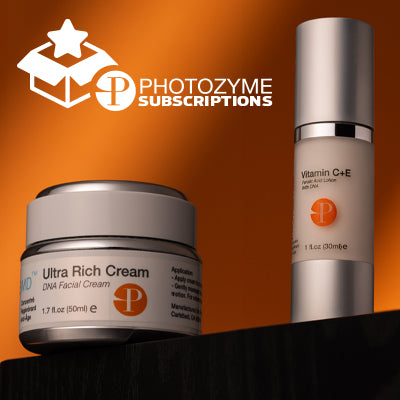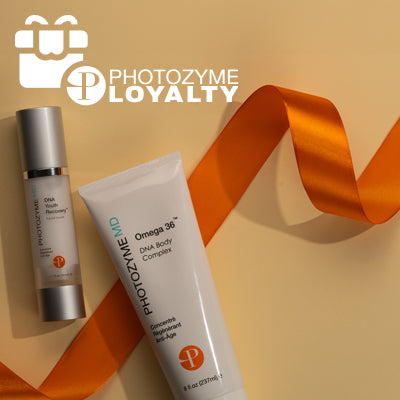
Learn how to tell skin purging vs. breakout apart. Get science-backed answers and take control of your anti-aging regimen with Photozyme.
Key Takeaways:
- Understanding The Cause: Skin purging is a temporary reaction triggered when active ingredients, such as retinoids or acids, increase cell turnover. This process quickly brings underlying congestion to the surface, while clogged pores, sebum buildup, or external irritants typically cause breakouts.
- Key Indicators To Watch: Pay attention to timing, location, and blemish type. Purging usually begins within days of starting a new active, and appears where you typically break out. Breakouts can occur unpredictably and may involve deeper, more inflamed lesions.
- How To Respond Effectively: During a purge, prioritize hydration and barrier-repairing products to help your skin tolerate increased turnover. Reduce actives and add anti-inflammatory or antibacterial support for breakouts until the skin calms and rebalances.
You don’t settle for hype, and neither do we.
At Photozyme, you get clinically validated skincare designed to perform at the cellular level. Every formula is powered by patented DNA repair enzymes, built on peer-reviewed science, and tested for real-world efficacy. With our advanced skincare, you restore function, defend structure, and future-proof your skin one layer at a time.
Navigating skin changes can be confusing, especially when new actives trigger unexpected flare-ups. Understanding skin purging vs. breakout means learning how to read your skin’s timing, texture shifts, and response patterns to treatment.
In this blog, we’ll examine how to spot critical differences between skin purging and breakouts, what triggers each response, and how to adjust your skincare routine to support recovery without sacrificing progress.
Compare Purging vs Breakout At A Glance
When introducing new active ingredients to your skincare routine, you may notice changes on your skin’s surface, sometimes quickly. It’s crucial to distinguish between skin purging and an actual breakout so you can respond appropriately and support your skin’s health at the molecular level.
Onset
- Purging: Starts within 1 to 2 weeks of introducing potent actives like retinoids, AHAs, or BHAs. This timing aligns with accelerated cellular turnover, which forces pre-existing microcomedones to surface faster than they naturally would.
- Breakout: It can begin at any point and is often unrelated to new skincare. Triggers include hormonal fluctuations, comedogenic ingredients, poor hygiene, or occlusive products that disrupt pore function and microbial balance, leading to clogged follicles and inflammation.
Duration
- Purging: Typically short-lived, resolving within 2 to 6 weeks as your skin adapts to increased turnover. If symptoms persist beyond this window, it may no longer be a purge and should be reassessed for irritation or reaction.
- Breakout: Can persist for weeks or worsen without proper intervention. Breakouts won’t self-resolve unless the root cause, like clogged pores, bacteria, or hormonal shifts, is addressed through ingredient changes, clinical treatments, or medical care.
Appearance
- Purging: It usually appears as small, uniform bumps (papules or pustules) in areas where you normally break out. These blemishes tend to clear faster, in sync with your skin’s renewal cycle initiated by active ingredients.
- Breakout: It may present anywhere on the face or body. Lesions, including blackheads, cysts, and inflamed nodules, can be more varied. They often arise in areas where skin is reacting to friction, occlusion, or irritants in cosmetics.
Type Of Blemishes
- Purging: Involves whiteheads, small pustules, or clusters of tiny bumps. These blemishes result from actives speeding up the skin’s exfoliation process and typically don’t include painful cysts or deeply inflamed nodules.
- Breakout: May include painful cysts, deep papules, blackheads, and inflamed nodules. The variation in size and depth of lesions usually points to acne triggers like excess sebum, bacteria, or barrier disruption—not an exfoliation response.
Associated Symptoms
- Purging: May cause light flaking or temporary tightness. Mild redness or sensitivity is common during early use of exfoliants, but discomfort typically improves with consistent application and proper barrier support using non-irritating moisturizers.
- Breakout: Often accompanied by inflammation, swelling, tenderness, or post-inflammatory hyperpigmentation. These symptoms indicate active inflammation or skin stress that needs calming, not continued stimulation from harsh or active skincare.
Underlying Cause
- Purging: Driven by actives that increase cell turnover, such as retinoids, glycolic acid, or salicylic acid. This reveals that underlying microcomedones (clogged pores beneath the skin) had already been developed before the product was introduced.
- Breakout: Usually caused by pore blockages from excess oil, dead skin, or acne-causing bacteria. It can also result from hormonal changes, poor barrier health, or a reaction to incompatible skincare ingredients or textures.
Best Approach
- Purging: Continue with the active product unless irritation worsens or becomes painful. Support your skin barrier using fragrance-free moisturizers, and introduce actives slowly, every third night at first, while monitoring your skin’s tolerance.
- Breakout: Discontinue new or suspect products and simplify your routine. Focus on calming ingredients like niacinamide, azelaic acid, or zinc. If symptoms persist beyond 6 weeks or worsen, seek professional dermatologic guidance.
Strengthen Your Skin Barrier During A Purge
A skin purge can feel discouraging, especially when you're committed to tackling fine lines, discoloration, or sun-related damage. But this phase is temporary, and your approach can make a world of difference during this period. When you’re experiencing increased cell turnover, often triggered by introducing potent actives like retinoids or exfoliating acids, prioritizing barrier strength is crucial.
Gentle Cleansing Is Your First Line Of Defense
Focus on gentle cleansing twice daily with a non-stripping formula that respects your skin’s natural lipid layer. Avoid harsh scrubs, strong surfactants, or high concentrations of actives during this period.
Hydration Anchors Barrier Recovery
Hydration should become your anchor. Look for humectants like glycerin or hyaluronic acid, paired with replenishing emollients such as squalane or ceramides to lock in moisture and reinforce the skin’s protective barrier.
Sun Protection Is Non-Negotiable During A Purge
Sunscreen is essential every morning, regardless of cloud cover or time spent indoors. During a purge, your skin may be more vulnerable to UV and environmental stressors. Seek out broad-spectrum mineral sunscreens that offer robust protection without increasing the risk of irritation.
Consistency And Restraint Support Skin Resilience
Finally, remember that less is often more. Resist the urge to layer multiple new products simultaneously or to increase the frequency of active use in hopes of faster results. Support your skin’s recovery system and focus on consistent care for optimal repair and renewal.
Modify Your Routine To Calm Breakouts Fast
When you’re dealing with breakouts, swift and smart changes to your skincare routine can make a measurable difference in both comfort and recovery.
Scale Back On Actives That Disrupt Barrier Repair
Pare back active ingredients. Strong exfoliants, retinoids, or acids, especially when layered, can aggravate already-inflamed skin or worsen irritation following a breakout. Consider shifting to a gentle, pH-balanced cleanser that removes debris and sunscreen without stripping your natural moisture barrier.
Moisturize With Lightweight, Barrier-Safe Ingredients
Hydration becomes essential. Opt for a lightweight, non-comedogenic moisturizer formulated to lock in water, soothe inflammation, and reinforce the skin’s natural defenses. Even acne-prone skin needs moisture to heal efficiently. Avoid heavy creams or occlusives that can potentially trap oils and exacerbate congestion.
Introduce Anti-Inflammatory Support With Precision
Introduce anti-inflammatory actives thoughtfully. Ingredients like niacinamide or centella asiatica can support the skin’s natural repair processes and visibly reduce redness. Spot treatments containing salicylic acid or benzoyl peroxide can be effective but should be used only on affected areas to minimize the risk of further irritation.
Protect Against UV Damage With Broad-Spectrum SPF
Throughout this adjustment, sun protection cannot be neglected. UV exposure can worsen discoloration and prolong healing time, so daily application of a broad-spectrum sunscreen designed for sensitive or breakout-prone skin is critical.
Avoid Manual Interference That Delays Healing
Resist the urge to pick or excessively touch affected areas. Your skin’s barrier is working hard to repair, and hands-on interference introduces bacteria and prolongs recovery. Give your skin the space and support it needs for a calmer, healthier appearance.
Pair DNA Repair Enzymes With Acne Care Safely
Navigating acne and skin aging signs can be clinically effective, especially when you understand the science behind your routine. DNA repair enzymes are compatible with acne-prone regimens and can actively support your skin’s resilience throughout targeted treatments.
Protect Against Barrier Disruption From Actives
If you use prescription products (like retinoids or benzoyl peroxide) for breakouts, your skin barrier can become vulnerable, increasing sensitivity and potential irritation. DNA repair enzymes step in at the molecular level to restore cellular health, supporting the skin’s ability to recover from environmental stress, UV exposure, and the micro-injuries triggered by active acne therapies.
Safe For Acne-Prone And Congested Skin
These advanced enzymes don’t clog pores or exacerbate breakouts, making them suitable for those already monitoring non-comedogenic routine ingredients. Clinical evidence suggests layering DNA repair enzyme serums under your acne treatments helps reduce visible redness, facilitates healthy cell turnover, and minimizes the risk of long-term pigment changes from post-acne inflammation.
Maximize Efficacy With Strategic Layering
Apply your DNA repair enzyme product after cleansing before any prescription or over-the-counter acne treatments for best results. Then, follow with a gentle moisturizer and sun protection. This sequence synergizes skin repair with acne management, helping you maintain firmness, smoothness, and lasting radiance while minimizing the chances of skin purging tipping over into persistent irritation.
Measure Visible Results After One Skin Cycle
Understanding the difference between skin purging and breakouts often involves careful observation throughout your skin’s natural renewal process. Dermatologists call this period a “skin cycle,” typically lasting around 28 days for most adults. Within this period, your skin completes a whole process of shedding dead cells and replacing them with healthy new ones.
Track Location And Progress Of Blemishes
To distinguish between a purge and a breakout, closely track changes throughout an entire skin cycle. During purging, blemishes generally clear more quickly and remain localized to areas where you’ve recently started using an active ingredient, such as retinoids, exfoliating acids, or DNA repair enzymes. New imperfections should diminish as your cycle progresses, often revealing smoother, brighter, and clearer skin by the end of four weeks.
Identify Persistent Or Spreading Breakouts
In contrast, traditional breakouts can persist longer or appear in new areas not associated with your treatment zone. These may include cystic or inflamed lesions, often showing no resolution pattern as your skin cycles. Monitoring your skin’s progress with photos, notes, or a skin health app can help you objectively track improvements or persistent irritation.
Evaluate Results After One Full Skin Cycle
Give your regimen time to perform through at least one skin cycle before making decisions about efficacy or tolerability. Consistent observation empowers you to identify whether the visible changes you’re experiencing are part of a purposeful renewal or a sign that your routine may need adjustment.
Final Thoughts
Understanding the difference between skin purging and a breakout is essential for making the right choices for your skin health, primarily when investing in clinical, anti-aging formulations. Purging is your skin’s way of accelerating the renewal process, often triggered by science-backed ingredients such as retinoids or exfoliants designed to enhance cell turnover. Breakouts, by contrast, are a sign that something is disrupting your skin’s balance or irritating it, think occlusive products, comedogenic formulas, or even stress.
At Photozyme, our DNA repair enzyme technology is designed with efficacy and skin harmony in mind. Each formula is non-comedogenic, paraben-free, and suitable for all skin types, so you can feel reassured when embarking on your anti-aging journey. If you ever feel uncertain, consult a dermatologist to ensure your regimen supports your skin’s repair. With the proper knowledge, you can navigate skin changes confidently and make choices that advance skin longevity and radiance.
Read also:
- How Long Does Skin Purging Last And How To Speed It Up
- Can You Use Vitamin C With Retinol? Expert Tips For Safe Skincare
- How To Lighten Skin Safely: Top Tips Dermatologists Recommend
Frequently Asked Questions About Skin Purging vs Breakout
What is skin purging?
Skin purging is a temporary reaction triggered when active skincare ingredients—such as retinoids or exfoliating acids—speed up cell turnover. As these new, healthy skin cells come to the surface, underlying congestion (clogged pores, microcomedones) is brought out faster than usual, resulting in more visible breakouts or flaking for a short period.
How can I tell if my skin is purging or breaking out?
Focus on timing and location. If new blemishes appear where you typically break out—and you’ve just started using a new product with active ingredients like retinol, AHAs, or BHAs—it’s likely purging. If breakouts appear in unusual areas or persist long after initiating a new product, you may be experiencing a true breakout or irritation.
How long should breakouts last?
A standard breakout can last anywhere from a few days to two weeks, depending on severity and skin type. If breakouts persist for several weeks without improvement, it may signal an underlying sensitivity or incompatibility with your skincare routine.
What causes skin purging?
Skin purging occurs when ingredients that accelerate skin cell turnover cause microcomedones to surface and clear out rapidly. This clearing process temporarily brings congestion to the surface, but it’s a sign that your skin is adjusting to an active ingredient, not worsening.
What triggers breakouts?
Clogged pores caused by excess oil, dead skin cells, bacteria, hormonal fluctuations, or comedogenic ingredients typically cause breakouts. They can also be triggered by stress, environmental aggressors, and certain skincare products that do not support the health of the skin.
Can you purge from non-active ingredients?
No, purging is explicitly linked to ingredients that accelerate cell turnover. Non-active, non-exfoliating, or non-retinoid ingredients do not cause purging. If a product without actives is causing pimples or irritation, you’re more likely to have a breakout or a reaction rather than a purge.





